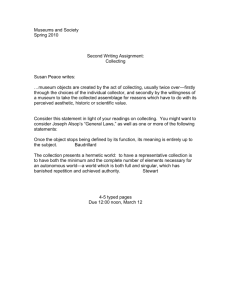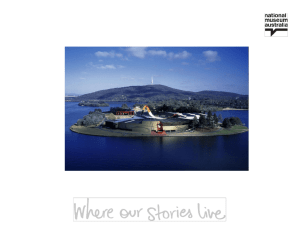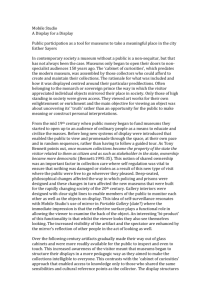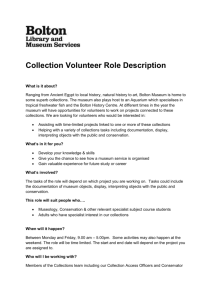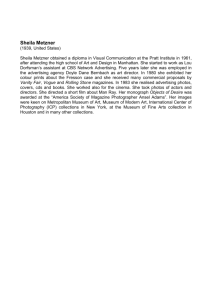SUPP A TWM ACQUISITION POLICY ETHNO NAT SCI
advertisement
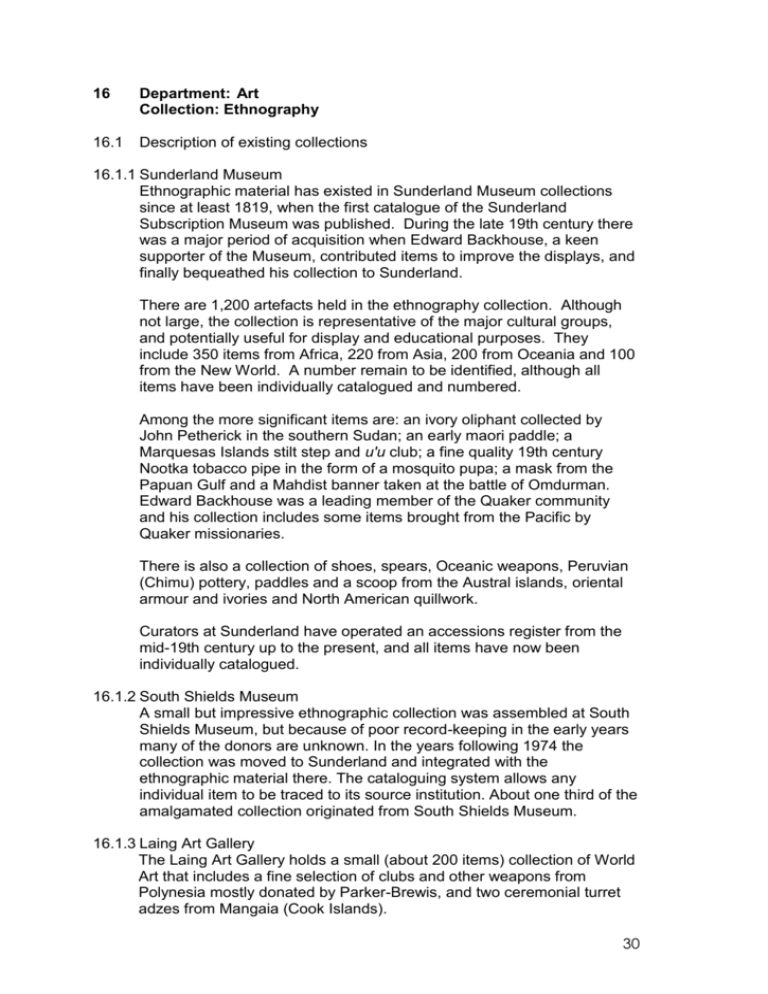
16 Department: Art Collection: Ethnography 16.1 Description of existing collections 16.1.1 Sunderland Museum Ethnographic material has existed in Sunderland Museum collections since at least 1819, when the first catalogue of the Sunderland Subscription Museum was published. During the late 19th century there was a major period of acquisition when Edward Backhouse, a keen supporter of the Museum, contributed items to improve the displays, and finally bequeathed his collection to Sunderland. There are 1,200 artefacts held in the ethnography collection. Although not large, the collection is representative of the major cultural groups, and potentially useful for display and educational purposes. They include 350 items from Africa, 220 from Asia, 200 from Oceania and 100 from the New World. A number remain to be identified, although all items have been individually catalogued and numbered. Among the more significant items are: an ivory oliphant collected by John Petherick in the southern Sudan; an early maori paddle; a Marquesas Islands stilt step and u'u club; a fine quality 19th century Nootka tobacco pipe in the form of a mosquito pupa; a mask from the Papuan Gulf and a Mahdist banner taken at the battle of Omdurman. Edward Backhouse was a leading member of the Quaker community and his collection includes some items brought from the Pacific by Quaker missionaries. There is also a collection of shoes, spears, Oceanic weapons, Peruvian (Chimu) pottery, paddles and a scoop from the Austral islands, oriental armour and ivories and North American quillwork. Curators at Sunderland have operated an accessions register from the mid-19th century up to the present, and all items have now been individually catalogued. 16.1.2 South Shields Museum A small but impressive ethnographic collection was assembled at South Shields Museum, but because of poor record-keeping in the early years many of the donors are unknown. In the years following 1974 the collection was moved to Sunderland and integrated with the ethnographic material there. The cataloguing system allows any individual item to be traced to its source institution. About one third of the amalgamated collection originated from South Shields Museum. 16.1.3 Laing Art Gallery The Laing Art Gallery holds a small (about 200 items) collection of World Art that includes a fine selection of clubs and other weapons from Polynesia mostly donated by Parker-Brewis, and two ceremonial turret adzes from Mangaia (Cook Islands). 30 16.2 Criteria governing future collection policy Active collecting will be restricted to acquiring objects for display, or to support exhibitions or learning and community programmes (see 16.4, below). 16.3 Period of time and/ or geographical area to which collecting will relate In accordance with 16.2 above, consideration will be given to material from all geographical areas. 16.4 Limitations on collecting There will be a presumption against building the collection further, except where historic collections of value to local communities may be acquired as part of cultural diversity work (see 16.2 above). 16.5 Collecting policies of other museums Specific reference is made to the following museums: Hancock Museum (large and diverse ethnographic collection) Captain Cook Birthplace and Dorman Museums, Middlesbrough (general ethnographic collection, and a separate body of material relating to areas visited by Cook) Hatton Art Gallery (collection of African woodcarving). 17 Department: Natural Sciences Collection: Biology 17.1 Description of existing collections 17.1.1 Sunderland Museum Natural Science collections at Sunderland originated with the Sunderland Subscription Museum, founded in 1810. The collections grew little until Sunderland Corporation took over the running of the museum in 1846, and there was a great period of expansion and acquisition between 1850 and 1900. Natural Science dominated the displays at Sunderland Museum until the 1960s, and a major gallery is still devoted to wildlife. Major donations to Sunderland have included the collections of Edward Backhouse and Charles T. Trechmann. Backhouse supported the museum by donation during his lifetime, and in 1907 his collection was given to the museum by Mrs Backhouse. The extent of the donation can be measured by the fact that the cabinets, when laid end-to-end, extended to 85 metres. Natural Science was a major element in his collection, and included fine quality minerals and fossils, butterflies and 31 moths, birds' eggs and mounted birds. Trechmann's collection, donated in the 1960’s, included objects of scientific importance as well as display material. 17.1.2 South Shields Museum and Art Gallery The displays at South Shields Museum, like those at Sunderland, were dominated by Natural Science from its foundation in the 1860s until the 1970s. The main collection at South Shields comprised the exotic birds and mammals prepared by local taxidermist William Yellowley (18231893). Following a period of expansion in the late 19th Century, there was a long period of stagnation and prior to 1974 there was no curator and the displays and collections were in the care of library staff. Much of the material deteriorated badly and was discarded in 1974, most of the remainder is held in store. 17.1.3 Shipley Art Gallery and Saltwell Towers Shipley Art Gallery opened to the public as an art gallery in 1917, and basement rooms were adapted to display the Earl of Ravensworth's bird collection in 1920. Later, Saltwell Towers was refurbished for use as a museum, and the Natural Science collections were transferred there in 1933. Following an infestation of dry rot, Saltwell Towers was closed to the public in 1969 and the collections were moved into store. The 350 birds in the Ravensworth collection are in an extremely fine state of preservation, and include a number of rare and exotic species. Saltwell Towers attracted other donations, including several major Birds' Egg collections, the most extensive being those of H. Russell Eastcott and Captain Hammond Nash. 17.1.4 Collections by type 17.1.4.1 Mammals and birds (5,000) Principal collections include material prepared by South Shields taxidermist William Yellowley (1823-1893), the collection of wealthy Sunderland banker Edward Backhouse (1808-1879) and Lord Ravensworth's (1869-1932) birds. The collections provide comprehensive coverage of the British fauna, and also include some rare exotic species such as Lion, Tiger and Leopard, many specimens of birds of prey, and a pair of the now-extinct Passenger Pigeon. 17.1.4.2 Osteology (2000) The osteological collection includes bone material from most British species, exotic skulls and a part-skeleton of a leopard. 17.1.4.3 Fish Reptiles and Amphibians (1500) A small collection of historic casts and mounts was supplemented in the 1970s by the acquisition of a comprehensive series of locally caught fish preserved in spirit. 17.1.4.4 Insects (ca 100,000) 32 The Backhouse collection of exotic butterflies includes specimens collected in the mid-19th Century. Other collections of British butterflies and moths provide a comprehensive coverage of the British species. Coverage of other groups is patchy, although some groups of Diptera (especially, hoverflies) are well represented, and a good series of Coleoptera has been built up in the course of recent fieldwork. 17.1.4.5 Molluscs (31,000) The shell collections include two major elements. The Backhouse collection comprises mainly exotic species and includes some material acquired through major early collectors such as Reeve and Cumming. Woodward's collection, donated in 1977, includes a number of type, figured and cited specimens and is supported by a library of books and offprints. 17.1.4.6 Birds' eggs (3,400) Several collections of birds' eggs have been donated over the years to all of the constituent museums of Tyne and Wear Museums. Most have been held in store since their donation, but both South Shields Museum and Saltwell Towers Museum once had eggs on display. The collections provide comprehensive coverage of the British fauna, and there are some exotic species also present. 17.1.4.7 Invertebrates (10,000) A collection of 900 microscope slides, mainly of diatoms, has never been thoroughly researched. Originating in the mid-19th century, the collection includes material from various local and national scientists. The Backhouse bequest included a collection of display-quality corals 17.1.4.8 Botany (16,800) The collections form an important herbarium with an extensive local flora, concentrating on County Durham (Vice-County 66). Pre-eminent elements include the 18th-century collection of Stephen Robson, and material collected by Rev. G.G. Graham in County Durham in the late 20th century. 17.2 Criteria governing future collection policy 17.2.1 Mammals and Birds Collections of local and international mammals are relatively good, and legally obtained specimens will continue to be accepted. Mounts, study skins and osteological preparations will be collected. Specimens of local birds offered to the Museum will be accepted providing that space can be made available for their immediate preservation. Mounts and study skins will be prepared. Because of legal constraints and conservation considerations, birds’ nests and eggs 33 will not be acquired, unless as part of a scientifically important, well documented and legally assembled collection. 17.2.2 Fish No active collecting is foreseen in the near future. The collections of spirit preserved specimens were developed during the 1970's but have been static since then. Further material will be acquired by donation if offered. Consideration will be given to the curatorial implications of accepting such material. 17.2.3 Amphibia and Reptiles Collections of these groups are small and there is no intention to expand them. 17.2.4 Entomology Collecting, predominantly through passive means, will continue within the geographic area. Field work (when applicable) will concentrate on Coleoptera, which are recognised as important indicators of environmental quality. There will be a presumption against accepting collections of butterflies and large moths (Macrolepidoptera), which are already well represented in the TWM collections. For this latter group, only local, well-documented collections of outstanding interest will be acquired. 17.2.5 Malacology TWM possesses large and important collections of Unionid bivalves from all over the world. This collection, however is an anachronism, and there will be no further collecting to expand this. Material of identified and provenanced British species may be accepted if offered. 17.2.6Other Invertebrates As might be expected, collections of other terrestrial, aquatic and marine invertebrates are mainly small. The exception is a large collection of corals from the Chagos Archipelago, which is currently on long-term loan to the Natural History Museum in London. The acquisition of this collection relates to a series of expeditions to the area from the University of Durham in the 1970s and 1980s. No further collecting in this particular field will be undertaken. Other than this, land invertebrates representative of the local fauna should be acquired as opportunities arise. Collections of terrestrial invertebrates, built up in the course of ecological studies within the collecting area, should be acquired providing they can be cared for. 17.2.7 Botany There is currently no botanical curatorial expertise, and little or no active collecting is currently being undertaken. However, should this curatorial expertise become available it is envisaged that active collecting will once again take place. Specimens will only be collected from County Durham and Tyne and Wear. Other material may be collected passively, particularly if part of a collection containing Tyne and Wear and County Durham specimens. The presumption, however, will be to re-direct nonregional material to a suitable, alternative museum. 34 17.2.8 Archives Archives relating to Natural Science collections or collectors represented in the collections of Tyne and Wear Museums will be acquired where possible. When considering the acquisition of archives, consideration must be given to their relevance to Tyne and Wear Museums, its ability to care for them, and the interests of other local repositories e.g. Tyne and Wear Archives, County Durham Records Office, Northumberland Record Office etc. 17.3 Period of time and/ or geographical area to which collecting will relate Current collecting activities reflect the regional role of Tyne and Wear Museums and concentrate on the historic county of Durham, or vice-county 66, and the North Pennines. (Vice-counties are recording units designated by the botanist Hewitt Cottrell Watson in his publication Topographical Botany [1873-4]). The Museum also collects from the marine environment of the North Sea. 17.4 Collecting policies of other museums Historically, Tyne and Wear Museums has acted as a regional centre for carrying out field collecting within the geographic area of County Durham and Tyne and Wear. In practice, County Durham means vice-county 66. (Vicecounties are recording units designated by the botanist Hewitt Cottrell Watson in his publication Topographical Botany [1873-4]). Specific reference is made to the following museums: Hancock Museum (Northumberland - overlap in Newcastle upon Tyne, North Tyneside and North Pennines) Cleveland County Museums Service (‘The North of England’ - overlap throughout) Hartlepool Museum (not actively collecting in the natural sciences) Stockton-on-Tees Museums (not actively collecting in the natural sciences) The Yorkshire Museum (North Yorkshire - overlap in County Durham south of the River Tees) Carlisle Museums (potential overlap along the North Pennines). 18 Department: Natural Sciences Collection: Geology 18.1 Description of existing collections 18.1.1 Sunderland Museum Natural Science collections at Sunderland originated with the Sunderland Subscription Museum, founded in 1810. The collections grew little until Sunderland Corporation took over the running of the museum in 1846, and there was a great period of expansion and acquisition between 1850 and 1900. Natural Science dominated the displays at Sunderland Museum until the 1960s, and a major gallery is still devoted to wildlife. 35 Major donations to Sunderland have included the collections of Edward Backhouse and Charles T. Trechmann. Backhouse supported the museum by donation during his lifetime, and in 1907 his collection was given to the museum by Mrs Backhouse. The extent of the donation can be measured by the fact that the cabinets, when laid end-to-end, extended to 85 metres. Geology was a major element of his collection and included fine quality minerals and fossils. Trechmann's collection, donated in the 1960’s, included objects of scientific importance as well as display material, and was rich in rocks, fossils and minerals. Other collectors of note include J.W. Kirkby, D.B. Smith, W. Hutton, and D. Woolacott. 18.1.2 South Shields Museum The displays at South Shields Museum, like those at Sunderland, were dominated by Natural Science from its foundation in the 1860s until the 1970s. The main collection at South Shields comprised the exotic birds and mammals prepared by local taxidermist William Yellowley (18231893). Most of the geological material consists of mineral specimen with a small number of Carboniferous and Jurassic fossils. 18.1.3 Shipley Art Gallery and Saltwell Towers Shipley Art Gallery opened to the public as an art gallery in 1917, and basement rooms were adapted to display the Earl of Ravensworth's bird collection in 1920. Later, Saltwell Towers was refurbished for use as a museum, and the Natural Science collections were transferred there in 1933. Following an infestation of dry rot, Saltwell Towers was closed to the public in 1969 and the collections were moved into store. Whilst the geology collections are quite small they include important Carboniferous fossil vertebrate material from the Coal Measure strata of Tyne and Wear. 18.1.4 Collections by type 18.1. 4.1 Palaeontology and Petrology (15,000) The largest part of the collection consists of Permian vertebrate and invertebrate fossils and rocks from the Zechstein strata of North East England. Important specimens include the only British example of a Permian Gliding Reptile (Coelurosauravus), one of only two British specimens of an early lizard-like reptile (Protorosaurus), the Holotypes of a Permian plant (Durhamia belli) and fish (Platysomus parvus, the oldest recorded specimen in Sunderland Museum dating back to 1815), together with numerous specimens which have been cited or figured in literature. Other fossil collections include numerous Carboniferous plants (including a fossil tree trunk), vertebrates from the Coal Measures strata of Northumberland and County Durham, including a rare Carboniferous amphibian from Usworth Colliery, and considerable invertebrate collections. There are also holdings of Jurassic vertebrates and invertebrates from Cleveland, North Yorkshire and southern England, and considerable lower Palaeozoic, Cretaceous, Tertiary and 36 Quaternary collections from localities throughout the UK and indeed the world. 18.1.4.2 18.2 Mineralogy (5000) Mineral collections consist of specimens collected principally from the North Pennine Orefield, but also include material from throughout the UK, Europe and other continents. This collection is particularly noteworthy for the quantity and quality of North Pennine ‘Spar’ minerals, many of which have been collected from localities which no longer yield quality specimens, as well as rare minerals such as alstonite. There are also considerable rock collections held at the museum, including a series of important cores collected from the North Sea during exploration for hidden coal reserves. Criteria governing future collection policy 18.2.1 Palaeontology and Petrology Rocks and fossils will continue to be acquired from the local collecting area. Field collecting will concentrate on building a representative collection of material from the Permian strata of North East England, in particular the Magnesian Limestone series. Suitable specimens from equivalent strata in other parts of the world should be collected to serve as comparative material and to augment the existing foreign Permian collection. Borehole cores and associated log sections from onshore and offshore exploration activities will continue to be acquired. Emphasis will also be placed on the continued acquisition of a representative collection of material from the Carboniferous strata of County Durham and Tyne and Wear. 18.2.2 Mineralogy The collections are particularly strong in minerals from the North Pennine Ore field and it is the intention to continue to build this collection through field collection, purchase and donations. Emphasis will be given to the acquisition of high quality display specimens and to the continued acquisition of specimens representative of secondary mineralisation within the ore field, as well as the mineralogy of the rest of County Durham and south Tyne and Wear. 18.2.3 Archives Archives relating to the Geology collections or collectors represented in the collections of Tyne and Wear Museums will be acquired where possible. When considering the acquisition of archives, consideration must be given to their relevance to Tyne and Wear Museums, its ability to care for them, and the interests of other local repositories e.g. Tyne and Wear Archives, County Durham Records Office, Northumberland Record Office etc. 37 18.3 Period of time and/ or geographical area to which collecting will relate Current collecting activities reflect the regional role of Tyne and Wear Museums and concentrate on the historic county of Durham, or vice-county 66, and the North Pennines. (Vice-counties are recording units designated by the botanist Hewitt Cottrell Watson in his publication Topographical Botany [1873-4]). TWM also collects borehole cores from the North Sea. 18.4 Collecting policies of other museums Historically, Tyne and Wear Museums has acted as a regional centre for carrying out field collecting within the geographic area of County Durham and Tyne and Wear. In practice, County Durham means vice-county 66. (Vicecounties are recording units designated by the botanist Hewitt Cottrell Watson in his publication Topographical Botany [1873-4]). Specific reference is made to the following museums: Hancock Museum (Northumberland - overlap in Newcastle upon Tyne, North Tyneside and North Pennines) Cleveland County Museums Service (‘The North of England’ - overlap throughout) Hartlepool Museums (not actively collecting in geology) Stockton-on-Tees Museums (not actively collecting in Geology) The Yorkshire Museum (North Yorkshire - overlap in County Durham south of the River Tees) Carlisle Museums (potential overlap along the North Pennines). 38
